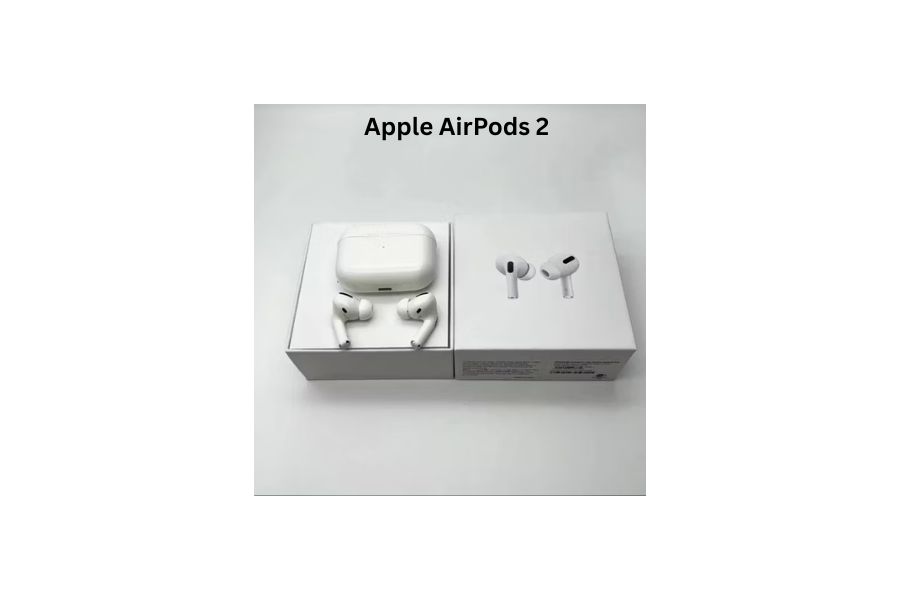Apple AirPods 2: When Apple first introduced the original AirPods back in 2016, they sparked a revolution in the wireless audio market. The sleek design, effortless pairing, and integration with the Apple ecosystem made them a go-to accessory for iPhone users. The AirPods 2, released in March 2019, brought some incremental but notable upgrades that helped solidify Apple’s dominance in the true wireless earbud category.
Now that several years have passed and newer models like the AirPods Pro and AirPods 3 are on the market, many users are wondering whether the AirPods 2 still hold up in 2025. In this in-depth review, we explore every aspect of the Apple AirPods 2, from design and performance to battery life and real-world usage, helping you determine if they remain a worthy purchase today.
Apple AirPods 2: Design and Comfort: Familiar Yet Iconic
The design of the Apple AirPods 2 is virtually identical to that of the first-generation model. Apple maintained the iconic stem-like structure that hangs just below the ear, a design that has since become widely recognizable. Made entirely of glossy white plastic, the earbuds look clean and modern, though some may find them a bit too glossy or prone to scratches over time. Despite their unusual appearance at launch, the design has proven to be functional and ergonomic.
In terms of comfort, the AirPods 2 are impressively lightweight and easy to wear for extended periods. The lack of silicone tips means that they do not create a tight seal in the ear canal, which some users appreciate for breathability and awareness of their surroundings. However, this design can also be a downside for users seeking better noise isolation or a more secure fit during rigorous activity. For everyday use, especially for calls, music, and podcasts around the home or office, the AirPods 2 deliver a comfortable experience that doesn’t fatigue the ears even after hours of wear.
Apple AirPods 2: Build Quality and Durability
Apple AirPods 2 has always maintained a high standard of build quality, and the AirPods 2 are no exception. The earbuds feel solid despite their light weight, and the magnetic charging case adds a reassuring click when closed. The case is small enough to slip into a pocket easily and sturdy enough to handle minor drops and scuffs. However, it’s worth noting that the AirPods 2 are not water- or sweat-resistant, which makes them less suitable for workouts or exposure to light rain. If you’re someone who tends to use earbuds during physical activity, you may need to be cautious with how and where you use these.
Apple AirPods 2: Setup and Connectivity
One of the standout features of the AirPods 2 is how seamlessly they connect with Apple devices. Thanks to the inclusion of the H1 chip, pairing is almost instantaneous. Simply opening the case near an iPhone or iPad triggers a pop-up animation prompting you to connect. Once paired, the AirPods 2 automatically sync across all devices linked to the same iCloud account, including iPads, Macs, and Apple Watches.
The H1 chip also brings improved connectivity and faster switching between devices compared to the first-generation AirPods. In daily use, the connection remains stable even in busy wireless environments like coffee shops, offices, or public transportation. Users rarely experience dropouts or connection lags, which makes the AirPods 2 a reliable companion for calls and music streaming.
Apple AirPods 2 Audio Quality: Balanced but Not Audiophile-Grade
When it comes to sound quality, the AirPods 2 offer a balanced and clean audio profile. The highs are clear without being overly sharp, the mids are warm and natural, and the bass, while present, is not particularly punchy or deep. These earbuds are tuned to deliver a pleasant listening experience across various genres of music, from pop and classical to podcasts and audiobooks. However, they fall short when compared to premium audio gear or even Apple’s own AirPods Pro, which provide a more immersive soundstage and deeper bass.
One important consideration is the lack of passive noise isolation due to the open-fit design. This means that outside noises can easily bleed into your listening experience, making the AirPods 2 less ideal for use in noisy environments. That said, some users prefer this openness for safety reasons, especially when walking or biking outdoors.
Apple AirPods 2: Call Quality and Voice Performance
The AirPods 2 excel in call quality, particularly for iPhone users. The dual beamforming microphones work together with the H1 chip to reduce background noise and focus on your voice. Callers on the other end consistently report clear audio, even when the user is in moderately noisy environments like a busy street or a car with the windows down. For voice assistants like Siri, the always-on “Hey Siri” functionality enables hands-free commands without tapping or touching the earbuds. This feature is particularly convenient when making calls, changing songs, setting reminders, or asking for directions, especially when your hands are occupied.
Apple AirPods 2: Battery Life and Charging Case
Apple AirPods 2 Battery performance is another area where the AirPods 2 perform well. Each earbud offers up to 5 hours of listening time on a single charge, and the charging case provides an additional 20 to 24 hours of usage. This adds up to nearly a full day of power before needing to plug the case in for recharging. Charging the earbuds for just 15 minutes in the case yields about 3 hours of playback, which is useful for quick top-ups.
Apple also offers a version of the AirPods 2 with a wireless charging case, which supports Qi-compatible charging pads. This feature adds convenience for users who already use wireless charging for their iPhones or Apple Watches. However, this wireless charging variant comes at a slightly higher price point. For users who don’t mind plugging in via Lightning cable, the standard version remains a cost-effective choice.
Apple AirPods 2: Software Integration and Ecosystem Compatibility
Perhaps the greatest strength of the AirPods 2 lies in their integration with the Apple ecosystem. From instant pairing to seamless device switching and iCloud-based syncing, the user experience is incredibly cohesive for Apple users. You can start listening to music on your iPhone, pause it, and then resume on your iPad or MacBook without skipping a beat. The earbuds also show up in the Control Center and Settings app, where you can customize their behavior, such as double-tap gestures for play/pause, next track, or activating Siri.
However, when used with non-Apple devices like Android phones or Windows PCs, the AirPods 2 become regular Bluetooth earbuds. Most of their smart features are lost, and audio performance, while still acceptable, doesn’t justify the premium pricing when not used within the Apple ecosystem.
Apple AirPods 2: Siri and Voice Assistant Performance
With the second-generation AirPods, Apple introduced hands-free “Hey Siri” support for the first time. This always-on feature makes it easier than ever to interact with your device. You can ask Siri to call someone, play a specific playlist, get weather updates, or even control your smart home devices, all without touching your phone or earbuds.
The voice recognition is impressively accurate, even in moderately noisy environments. This makes the AirPods 2 a truly voice-first device and a convenient extension of the iPhone, especially for users who frequently use Siri.
Apple AirPods 2: Use Case Scenarios and Real-World Experience
In real-world usage, the AirPods 2 shine in everyday activities. Whether you’re commuting, working from home, attending virtual meetings, or going for a walk, they perform admirably. The case is compact and easy to carry, the earbuds connect quickly, and the controls are intuitive. Music sounds good enough for casual listening, and calls are crystal clear for both parties.
One notable drawback is the lack of customizable ear tips, which means they may not fit securely in every ear. Users with larger or smaller ears may find them either too loose or too tight, which can affect both comfort and sound quality. In addition, the lack of water resistance limits their versatility for sports or rainy days.
Apple AirPods 2: Price and Value Proposition in 2025
As of 2025, the Apple AirPods 2 are no longer the latest model, but they remain available through Apple and other retailers at a reduced price. Their affordability compared to newer models like the AirPods Pro or AirPods 3 makes them a more budget-friendly option for Apple users who want core features like fast pairing, reliable audio, and seamless ecosystem integration without paying a premium.
For users who don’t need active noise cancellation or a customizable fit, the AirPods 2 still represent solid value. However, if you are looking for better sound, more features, or workout-friendly durability, you may want to explore alternatives like the AirPods Pro, Beats Fit Pro, or even third-party options from Sony or Samsung.
Apple AirPods 2: Competitor Comparison
When compared to similarly priced wireless earbuds from other brands, the AirPods 2 hold their own primarily because of their tight Apple integration. Competitors like Samsung Galaxy Buds, Jabra Elite, or Sony WF series may offer superior sound or features like noise cancellation and better water resistance, but they often lack the ease-of-use and ecosystem support that Apple users value.
That said, if you’re not deeply embedded in the Apple ecosystem, these competitors could offer a more rounded package in terms of audio quality and hardware features for the same or lower price.
Apple AirPods 2: Longevity and Software Updates
Apple AirPods 2 has an excellent track record of supporting older devices with software updates, and the AirPods 2 continue to receive firmware improvements that enhance stability and compatibility. This extends their usability beyond what many expect from wireless accessories, which are often quickly outdated by rapid technological advancement.
While they may not support every new feature introduced in future iOS versions, the AirPods 2 are likely to remain functional for years to come, especially for core tasks like listening and calling.
Apple AirPods 2 Conclusion: Still a Strong Contender for Apple Users
In conclusion, the Apple AirPods 2 continue to be a strong option in 2025 for users seeking simple, reliable, and well-integrated wireless earbuds within the Apple ecosystem. They may lack premium features like active noise cancellation or customizable tips, but their strengths in connectivity, comfort, call quality, and ease of use still make them relevant. For users heavily invested in the Apple environment, they offer unmatched convenience at a now more affordable price point.
If you’re considering a pair of wireless earbuds and you primarily use Apple products, the AirPods 2 remain a smart and capable choice. However, for audiophiles, fitness enthusiasts, or Android users, there may be better alternatives in the market. Ultimately, the AirPods 2 have aged gracefully and continue to deliver a solid experience, proving that Apple’s design philosophy and ecosystem integration still hold strong several years after their release.

